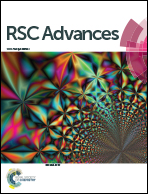The dynamic CO2 adsorption of polyethylene polyamine-loaded MCM-41 before and after methoxypolyethylene glycol codispersion†
Abstract
To reduce the cost of CO2 capture, polyethylene polyamine (PEPA), with a high amino density and relatively low price, was loaded into MCM-41 to prepare solid sorbents for CO2 capture from flue gases. In addition, methoxypolyethylene glycol (MPEG) was codispersed and coimpregnated with PEPA to prepare composite sorbents. The pore structures, surface functional groups, adsorption and regeneration properties for the sorbents were measured and characterized. When CO2 concentration is 15%, for 30, 40 and 50 wt% PEPA-loaded MCM-41, the equilibrium adsorption capacities were respectively determined to be 1.15, 1.47 and 1.66 mmol g−1 at 60 °C; for 30 wt% PEPA and 20 wt% MPEG, 40 wt% PEPA and 10 wt% MPEG, and 50 wt% PEPA and 5 wt% MPEG codispersed MCM-41, the equilibrium adsorption capacities were respectively determined to be 1.97, 2.22 and 2.25 mmol g−1 at 60 °C; the breakthrough and equilibrium adsorption capacities for 50 wt% PEPA and 5 wt% MPEG codispersed MCM-41 respectively reached 2.01 and 2.39 mmol g−1 at 50 °C, all values showed a significant increase compared to PEPA-modified MCM-41. After 10 regenerations, the equilibrium adsorption capacity for codispersed MCM-41 was reduced by 5.0%, with the regeneration performance being better than that of PEPA-loaded MCM-41, which was reduced by 7.8%. The CO2-TPD results indicated that the mutual interactions between PEPA and MPEG might change basic sites in MCM-41, thereby facilitating active site exposure and CO2 adsorption.



 Please wait while we load your content...
Please wait while we load your content...